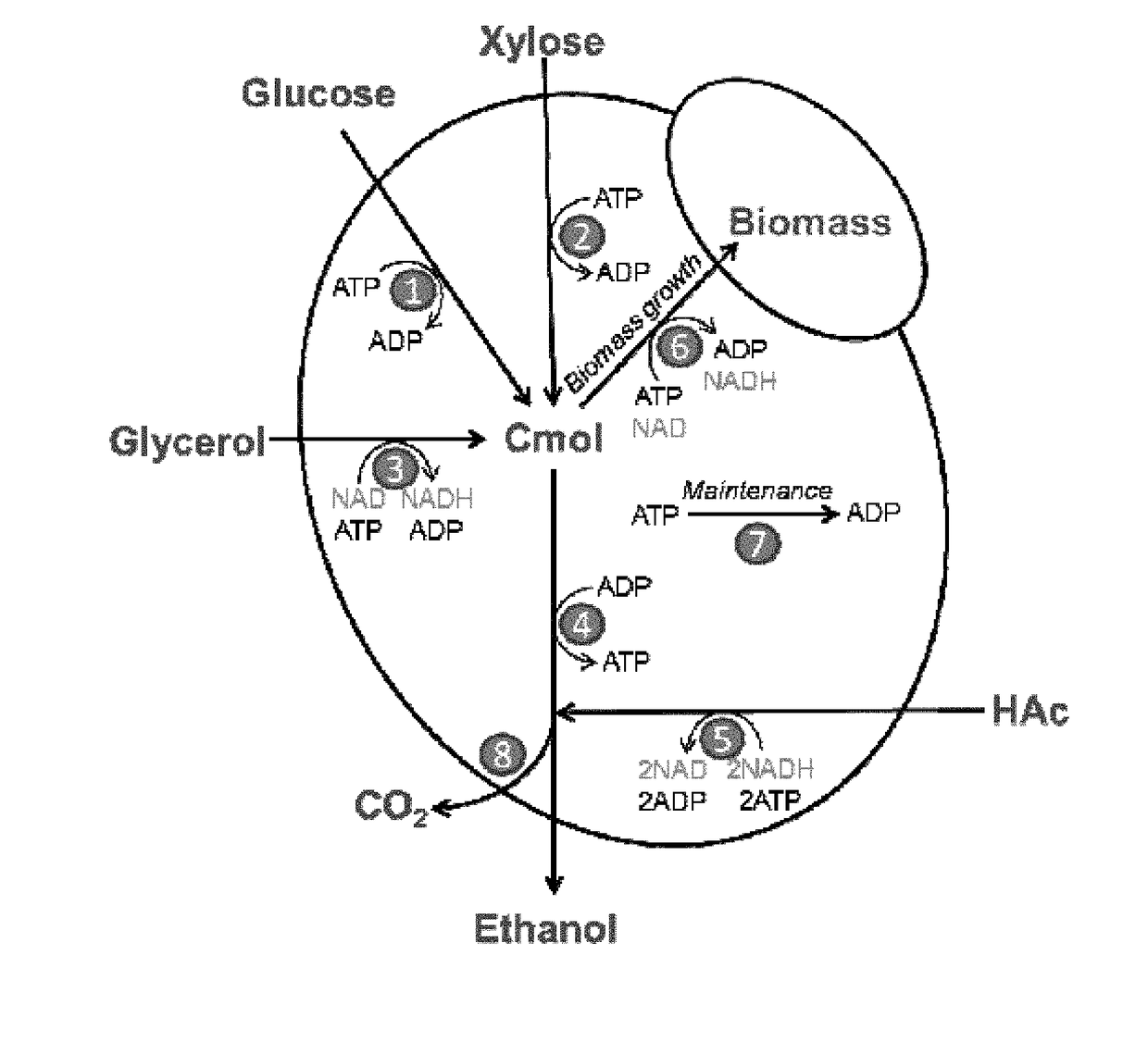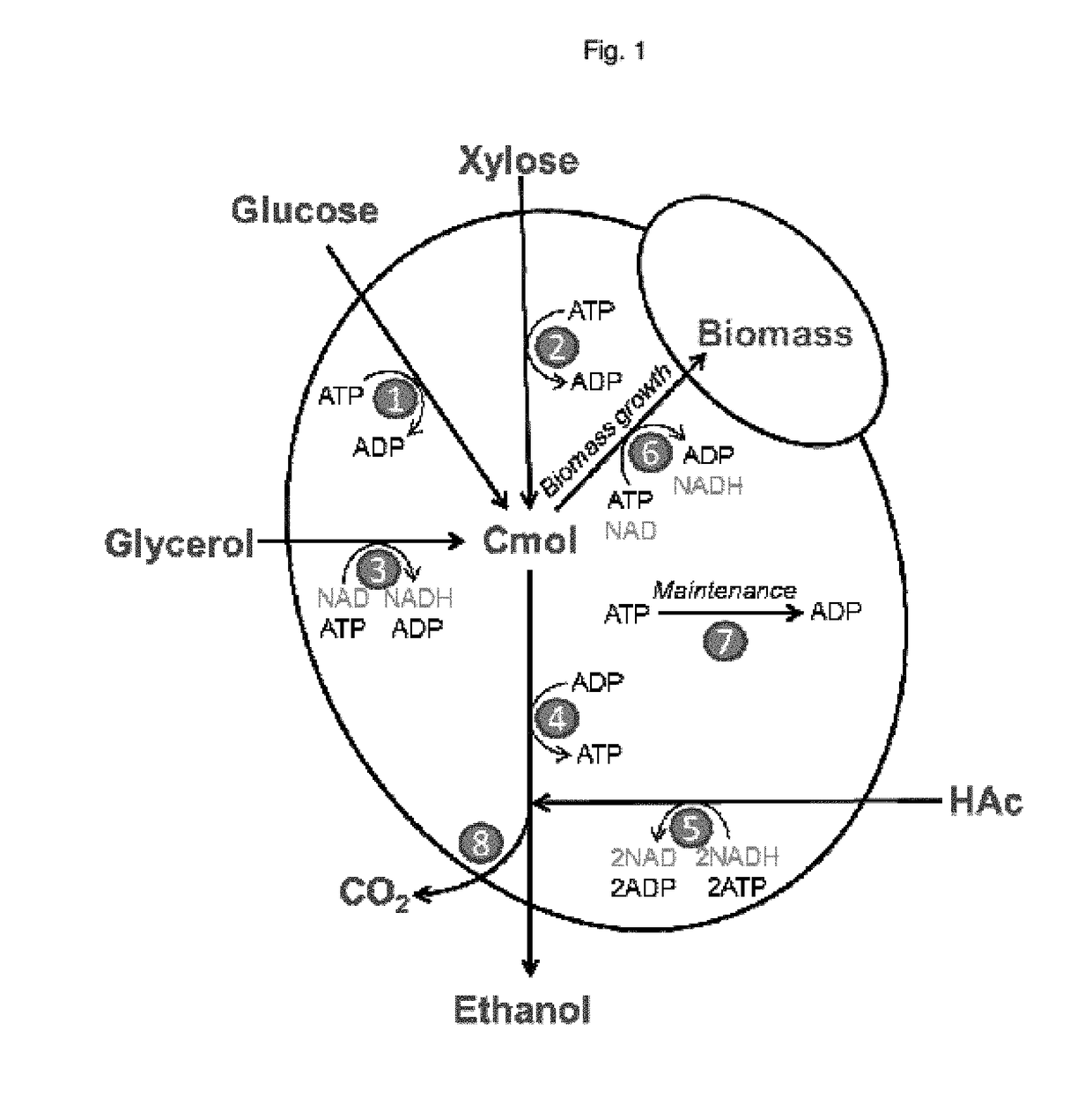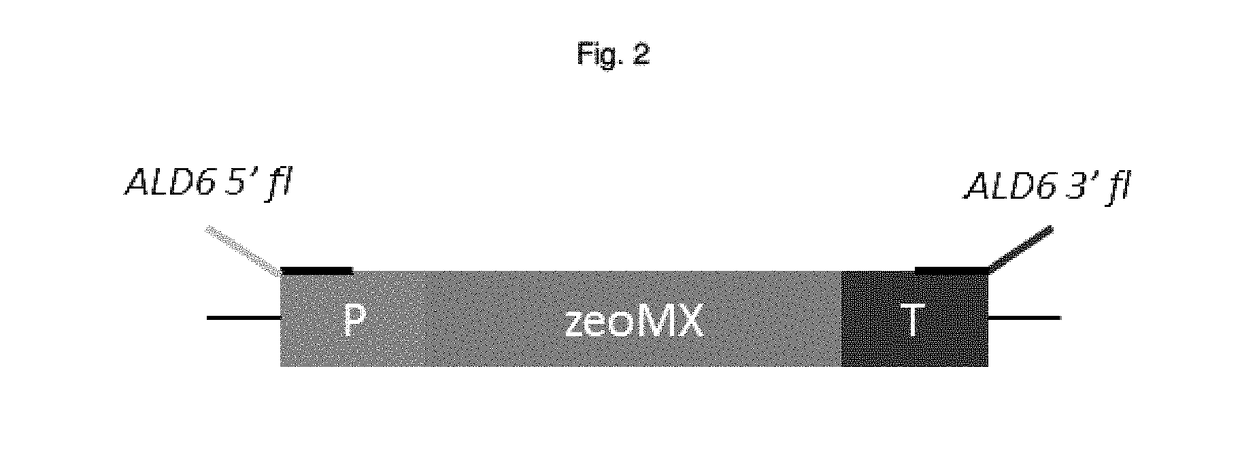Acetate consuming yeast cell
a technology of acetate and yeast cells, applied in the field of acetate-consuming yeast cells, can solve the problems of cofactor imbalance, toxic by-product formation, and both approaches have relatively limited effects, and achieve the effect of reducing the fermentation time of c5/c6
- Summary
- Abstract
- Description
- Claims
- Application Information
AI Technical Summary
Benefits of technology
Problems solved by technology
Method used
Image
Examples
example 1
[0228]Modeling Effect of Decreasing Maintenance ATP on Glucose and Xylose Conversion Rates
[0229]Simulations with the mathematical model were performed to identify opportunities for improving the glucose and xylose conversion rates of glycerol and acetate converting yeast strains. The simulations indicated that high maintenance ATP demand of the cells delays xylose and glucose to ethanol conversions (see, FIG. 3). FIG. 3 shows predictions of the fermentation performance for a reference maintenance ATP demand (black lines), 10% decreased maintenance ATP demand (dashed grey lines) and 50% decreased maintenance ATP demand (dotted black lines). The 10% and 50% decrease in maintenance ATP was implemented by setting model parameter k1 (see, Table 2) to 5.4e-3 and 3e-3 (mol / gDW / hour), respectively. These results clearly show that the decreasing the maintenance ATP demand increases the rate of sugar to ethanol conversion. Even a small decrease in maintenance ATP (−10%) has already a signific...
example 2
[0230]Identification of Disrupting Futile Cycle as Target for Decreased Maintenance ATP Demand
[0231]The mathematical model predicted that decreasing the maintenance ATP demand will increase the sugar to ethanol conversion rates (see, Example 1). A possible source of maintenance ATP turnover is futile cycling. To enable acetate to ethanol conversion an acetylating acetaldehyde dehydrogenase (e.g., adhE or acdH) was introduced in the strains (see WO2015028583 and WO2015028583. This also introduced a possible futile cycle in the strains, see FIG. 4.
[0232]FIG. 3 shows a schematic overview of the metabolic pathways involved in futile cycling of acetaldehyde-acetate-acetyl-CoA, causing an increased maintenance ATP. The futile cycle is indicated by dotted arrows. The acetylating acetaldehyde dehydrogenase (adhE, acdH) was introduced in the strain to enable acetate to ethanol conversion.
[0233]Disruption of the futile cycle is expected to decrease the maintenance ATP and thereby improve the ...
example 3
[0234]AFM Test of ALD6 Knock-Out Strain
[0235]In order to experimentally verify the model predictions that ALD6 deletion increases the sugar to ethanol conversion rates the following strains were tested in AFM:
[0236]1. YD01248 (reference)
[0237]2. YD01248 (ald6::loxPzeoMXloxP) col. #7, herein “YD01248 ΔALD6”
[0238]3. YD01247 (reference)
[0239]4. YD01247 (ald6::loxPzeoMXloxP) col. #2, herein “YD01247 ΔALD6”
[0240]Every 6 hours, samples were taken for HPLC analysis, in order to determine the residual sugar concentration and the ethanol formation. The results are presented in FIG. 5. FIG. 5 shows a comparison of sugar consumption and ethanol formation rates between reference (YD01248, YD01247; transparent lines) and ALD6 deletion strains (YD01248 ΔALD6, YD01247 ΔALD6; solid lines).
[0241]Table 12 summarizes the ethanol yields on total sugars for the reference vs. ALD6 deletion strains at 48 hours and 72 hours. FIG. 5 and Table 7 indicate that in both reference strains the ALD6 deletion resul...
PUM
| Property | Measurement | Unit |
|---|---|---|
| fermentation time | aaaaa | aaaaa |
| concentration | aaaaa | aaaaa |
| temperature | aaaaa | aaaaa |
Abstract
Description
Claims
Application Information
 Login to View More
Login to View More - R&D
- Intellectual Property
- Life Sciences
- Materials
- Tech Scout
- Unparalleled Data Quality
- Higher Quality Content
- 60% Fewer Hallucinations
Browse by: Latest US Patents, China's latest patents, Technical Efficacy Thesaurus, Application Domain, Technology Topic, Popular Technical Reports.
© 2025 PatSnap. All rights reserved.Legal|Privacy policy|Modern Slavery Act Transparency Statement|Sitemap|About US| Contact US: help@patsnap.com



